The Evolution of GI-Inspired Dressing: Fashion’s Wartime Pivot and Post-War Impact
Impact of World War II on global fashion trends
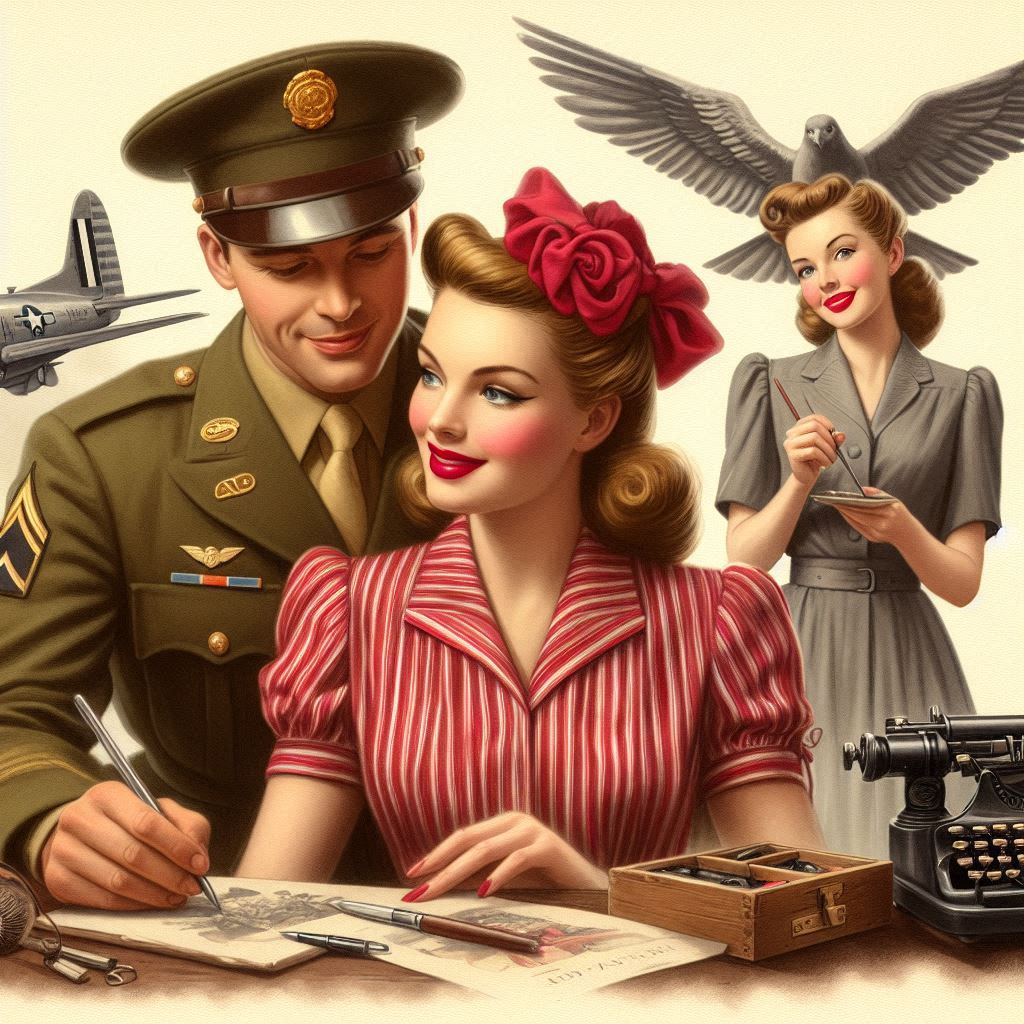
The 2nd World War had a profound impact on global fashion trends, influencing styles, materials, and the way in which people dressed. Here are some key factors on how the war affected fashion:
Resource Scarcity and Rationing
Fabric Rationing: Due to textile shortages – governments in the U.S imposed restrictions on fabric use. Dress hems or belts could not exceed two inches in width, whilst all garments could not have more than one pocket, and they banned ornamental sleeves, hoods, and scarves. The War Production Board issued regulations to conserve materials, which led to simpler designs with less fabric. Incidentally, metal and rubber was also restricted by the government.
Utility Clothing: In the UK, their government introduced the “Utility Clothing Scheme”, which promoted durable, practical garments made from minimal fabric. This rationing changed the course of fashion when it limited the amount of fabric people could use, and what was socially acceptable attire. People compromised for the lack of many textiles and clothing. They invented new styles with existing fabrics, hence clothing became standardized for all, but had to meet government specifications.
Changes in Silhouettes and Styles
Simplified Silhouettes: Due to less fabric available, clothing became more streamlined and functional. Women often wore knee-length dresses, with narrow skirts and fitted waists.
Military Influence: Military uniforms inspired civilian fashion trends. Features like shoulder pads, belted waists, and double-breasted coats became popular – reflecting a more structured and utilitarian look.
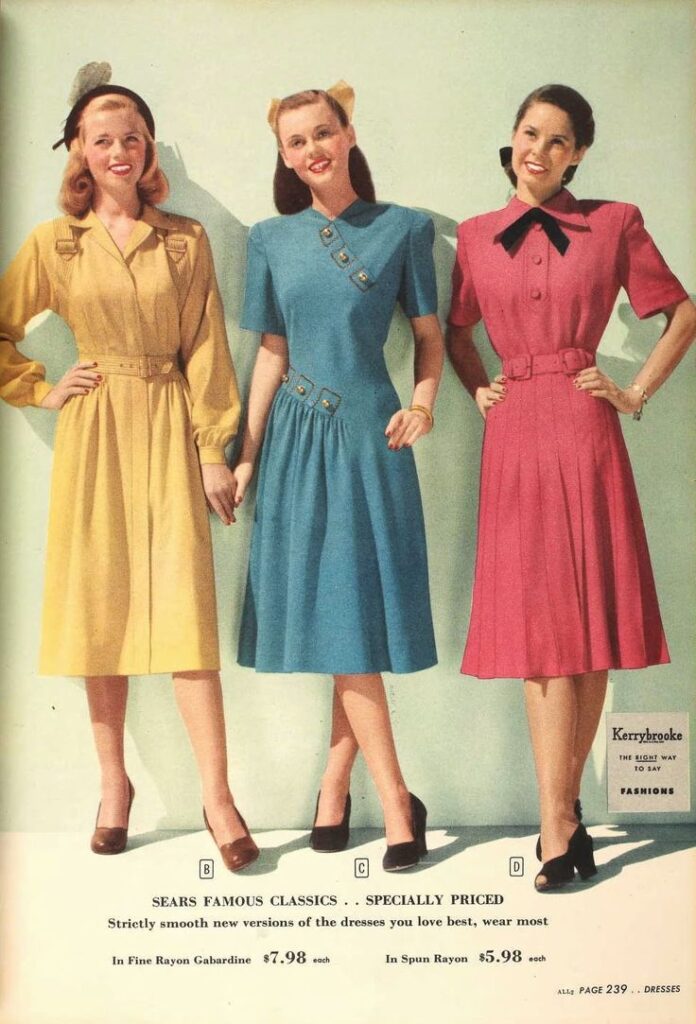
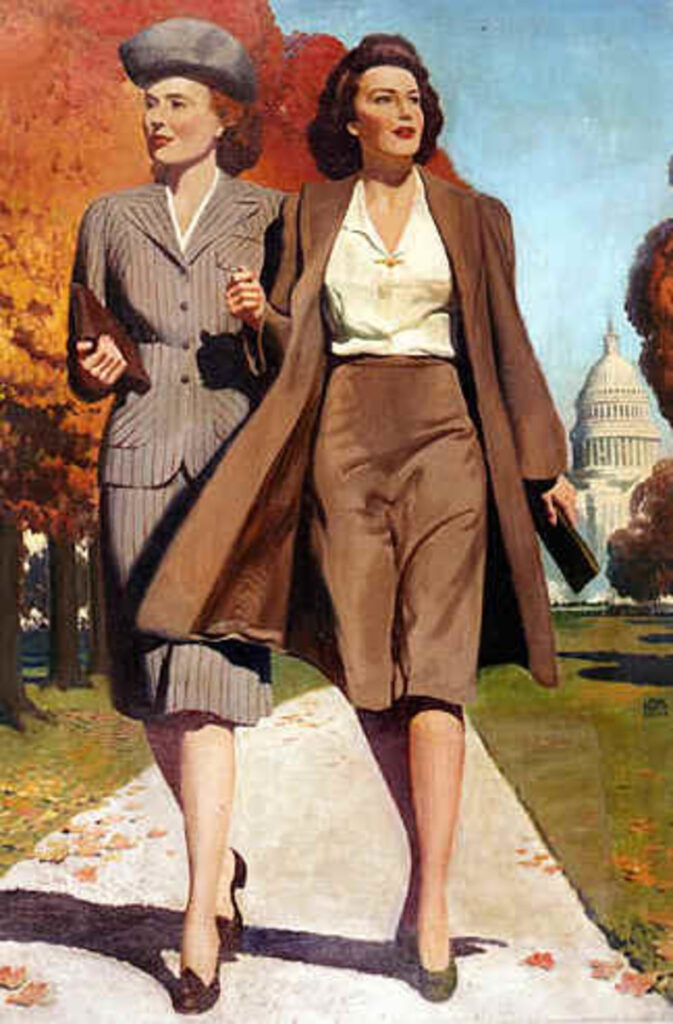
Practicality and Functionality
Work-wear: As women entered the workforce in great numbers, there was a rise in practical clothing such as trousers, overalls, and jumpsuits. These garments were designed for functionality, protection and ease of movement.
Hosiery and Stockings: Silk was diverted to the military to be used as wound healing and protection against pests, this in turn lead to shortages of stockings. Whilst nylon was diverted to the war effort to make ropes, parachutes and tarps, it even earned the title of the “fibre that won the war”. Women resorted to leg makeup to simulate the appearance of stockings by tinting their legs with diluted browning and drew a ‘seam’ in the back using eyebrow pencil.
Post-War Changes and the New Look
New Look by Dior: In 1947, and after the 2nd World War, Christian Dior introduced the “New Look,” characterized by full skirts, nipped-in waists, and an overall return to femininity and luxury. This was a reaction against the austerity of wartime fashion, and marked a new era of opulence.
Revival of Haute Couture: Paris re-emerged after the war as the fashion capital, and haute couture experienced a resurgence. Designers once again focused on lavish designs using luxurious fabrics.
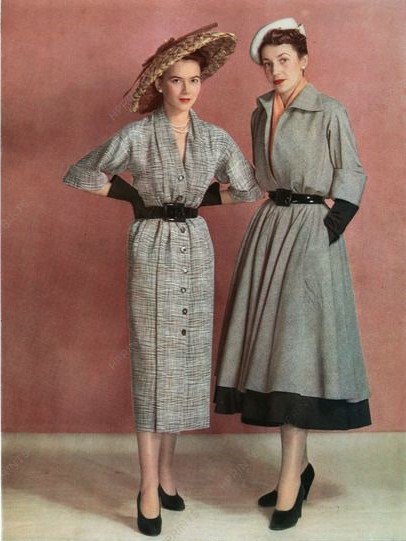
Cultural Influence and Adaptation
International Influence: The war facilitated cultural exchange, as International military personnel and refugees, brought different fashion influences to new places and countries. American fashion – for instance, gained popularity in Europe.
Adaptation to Local Conditions: In occupied and war-affected countries, people adapted fashion to local conditions and resources made available to them, but often making do with what they had. Women resorted to new ways to make themselves look attractive, including dying their legs to look like stockings – as they had no real cosmetics, and used beetroot juice for lipstick.
Impact on Men’s Fashion
Military Style: Men’s fashion was highly influenced by military uniforms. The popularity of bomber jackets, trench coats, and military boots can be traced back to this war era.
Casual Wear: The war popularized casual, practical clothing for men. Items like the white T-shirt, famously worn by Marlon Brando and James Dean ( which was part of the military uniform), became mainstream.
Technological Advancements
New Materials: The development of synthetic fibers such as rayon and nylon, driven by wartime research, had a lasting impact on fashion. These materials became more widely used in the post-war period and still do today.
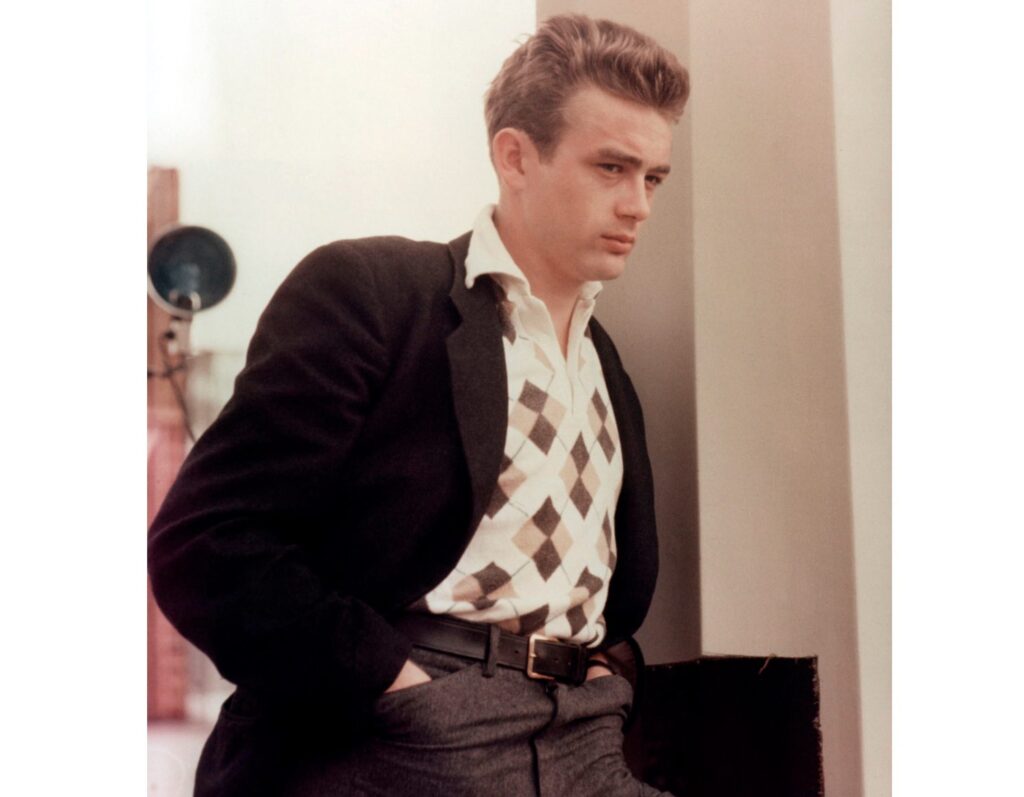
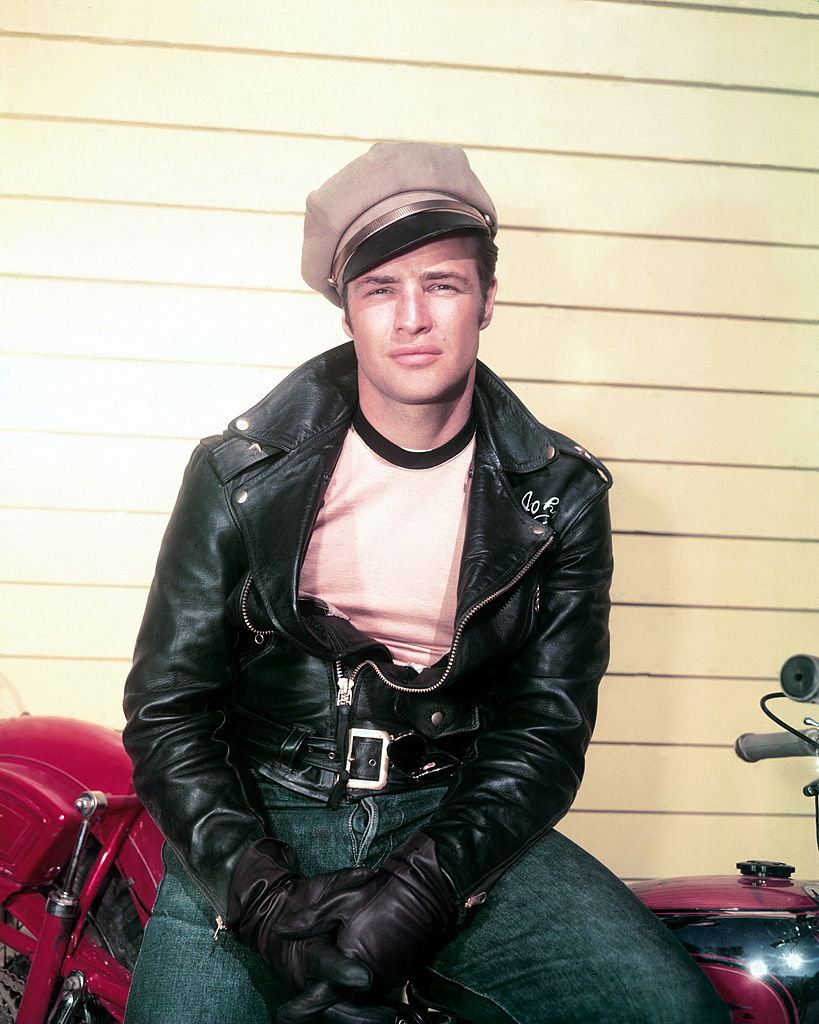
Women’s Liberation and Fashion
Role of Women: The war years saw women taking on roles traditionally held by men, which influenced their clothing choices. Many women returned to traditional roles post war, however the influence of their wartime experiences were driven by fashion choices – that balanced practicality and style.
Overall, World War II brought about significant changes in global fashion, emphasizing practicality and resourcefulness during the war years and paving the way for a resurgence of luxury and femininity in the post-war era.
How wartime uniforms influenced civilian attire
Uniforms worn during war times have had a significant influence on civilian attire throughout history. Such influence is evident in several key areas:
Practicality and Functionality
The Great War (1914-1918):
Trench Coats: Originally designed for British officers, trench coats became popular due to their practicality, warmth, weather resistance, and stylish look. Post-war – these were adapted by designers for civilian use, and remain a fashion staple. Assorted trench coats can be sourced here through Amazon.
Cardigans and Pull-overs: These were commonly worn by soldiers in the winter for comfort and warmth, but after the war, they became popular among civilians as they were practical and easy to make and wear. Scroll through this selection of knitwear today.
World War II (1939-1945):
Bomber Jackets: Initially designed for pilots to keep warm in unheated cockpits, bomber jackets became fashionable for their rugged, masculine style and functionality, though women have worn them as early as from the 1950’s. An assortment of vintage inspired bomber jackets can be found online at this store.
Utility Clothing: Due to rationing and the need for practicality, civilian clothing adopted a more utilitarian style, with simpler lines and multifunctional pieces like jumpsuits and overalls. Utilitarian inspired clothing for women can be obtained through this site – learn more about these today.
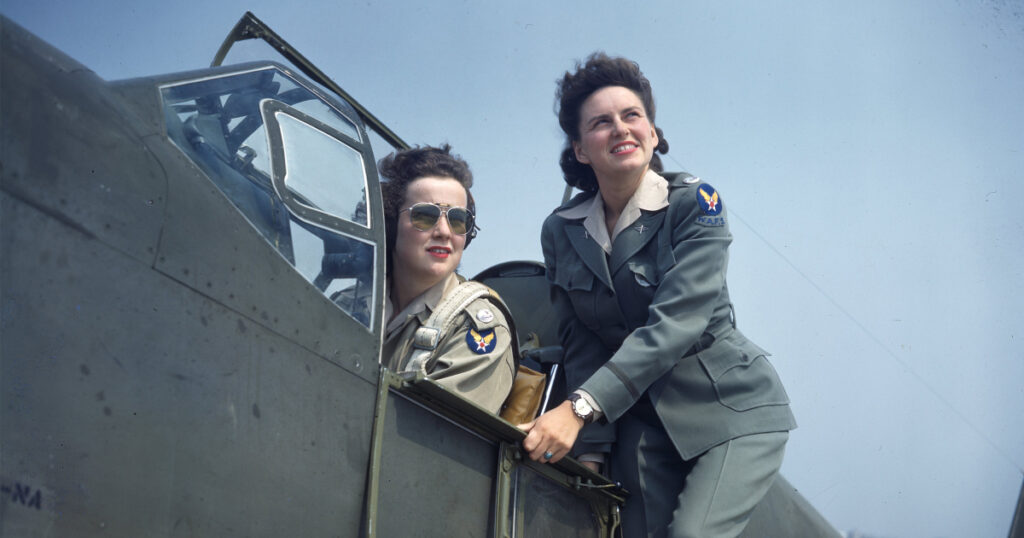
Influence on Women’s Fashion
World War II:
Trousers for Women: As women took on more roles traditionally held by men, including industrial and agricultural work, trousers were a practical necessity. Post-war, trousers remained popular among women, and as a symbol of empowerment and workability. If you are into the utilitarian look, find your style right here.
Victory Rolls and Hairstyles: Hairstyles like finger rolls and victory rolls – which kept hair away from face and machinery, became fashionable and remained popular throughout civilian life.
Post-War Adaptations
1940’s-1950’s:
The New Look: Post-WWII, with reactions against how austere wartime clothing was, designer Christian Dior developed the “New Look” of 1947 – characterized by cinched waists and full skirts, marking a return to femininity and luxury, influenced by the desire to break away from utilitarian styles of the war years.
Peacoats and Military Boots: These items that were initially used by the navy and army, found their way into civilian wardrobes due to their durability and style. Civilians living in colder continents favoured ex military boots for functionality and practicality. Cute but functional peacoats can be sourced here today. They also stock military style boots for women here.
Modern Influence
Post-2000’s:
Camouflage and Military-Inspired Fashion: Camouflage patterns and military-inspired designs like cargo pants and combat boots have been very popular in civilian fashion – often symbolizing a rugged, rebellious style. A variety of cargo pants can be found through this store online today.
Ath-leisure: Modern ath-leisure have frequently borrowed suggestions from military designs, with elements like tactical vests and bomber jackets – being incorporated into everyday wear. Tactical vests of interest are purchasable right here.
As an affiliate I may receive a commission when you click on a link and purchase in this post
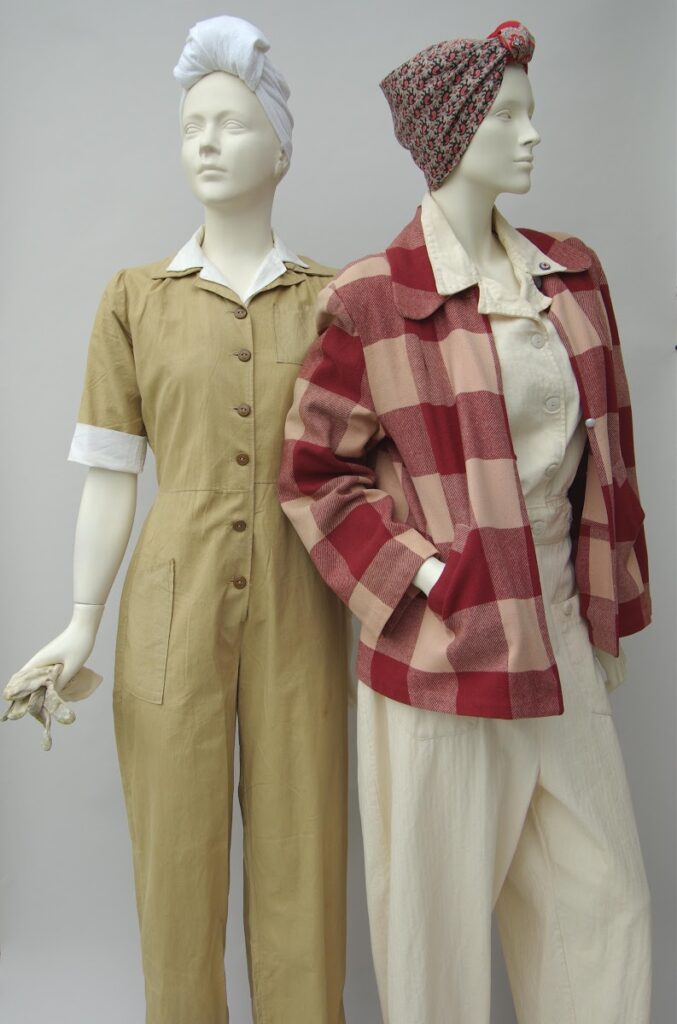
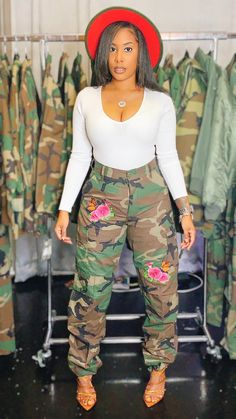
Social and Cultural Impact
Symbolism and Identity: Military uniforms can carry symbolic weight – representing strength, unity, and resilience. Incorporating these uniforms elements into civilian attire is a way for individuals to express solidarity, patriotism, or a connection to military heritage.
Youth and Subcultures: Various youth subcultures have adopted military surplus clothing as part of their identity, such as the mods in the 1960’s with their parka jackets, or punk rockers in the 1970’s and 1980’s with their use of military boots and jackets.
Wartime uniforms have left an indelible mark on civilian fashion, blending practicality with style and influencing cultural expressions of identity and resilience. This interplay between military and civilian attire continues to evolve, reflecting changing societal values and technological advancements.
Key features and elements of GI inspired fashion
GI-inspired fashion, drawing from the attire and gear of U.S. military personnel, incorporates several key features and elements. These elements emphasize functionality, durability, and utilitarian design while often carrying symbolic weight. Here are the key features and elements of GI-inspired fashion:
Camouflage Patterns
Design: Various camouflage patterns, such as woodland, desert, and digital, are used to mimic the appearance of vintage and modern military uniforms.
Usage: Commonly seen in jackets, pants, t.shirts, hats, and accessories.
Military Jackets
Field Jackets: Lightweight, with multiple pockets and often a drawstring waist. The US Army M-65 field jacket is a classic example. This field jacket was created in 1965 and introduced for the U.S. Army which was widely used by troops during the Vietnam War. A variety of field jackets are here for your perusal through Amazon.
Bomber Jackets: Initially designed for pilots, characterized by a fitted collar, waist and cuffs, and a more substantial build for warmth. Casual and dressy style bomber jackets are bought here – look at these selections.
Parkas: Long, hooded jackets designed for extreme cold, often with fur-lined hoods. Vintage inspired parkas are right here for you to select today.
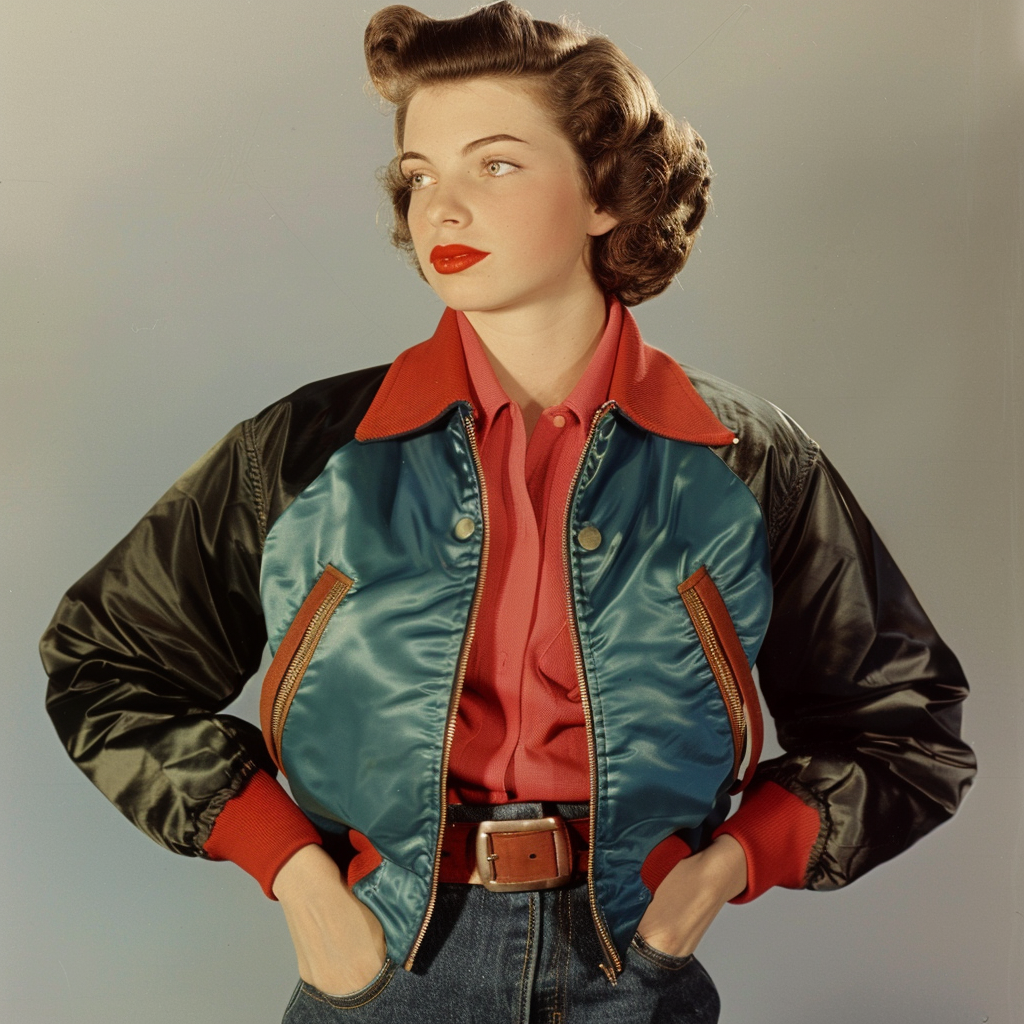
Cargo Pants and Shorts
Design: Known for their multiple large pockets, cargo pants and shorts emphasize practicality and storage capacity. Many styles of cargo shorts can be located today through Amazon.
Materials: Typically made from durable fabrics like cotton twill or the mid century ripstop.
Combat Boots
Features: Sturdy construction, ankle support, and rugged soles designed for rough terrain. Once again combat boots are purchasable at this online store.
Styles: Classic styles include the jungle boot and desert boot, often featuring laces and sometimes zippers for quick removal.
Utility Vests and Tactical Gear
Design: Vests with multiple pockets and compartments, often used for carrying personal items, gear and equipment. Look at the selection of casual and function utility vests here.
Incorporation: Adapted for everyday use, such as in fishing vests, for photographer’s vests, and fashion-forward tactical vests.
Dog Tags and Accessories
Dog Tags: Metallic identification tags worn on a chain around the neck, which variations of such are often used as durable and versatile fashion accessories, complementing a style worn by men. Rugged or dressy dog tags are found right here – look through their selections.
Belts and Buckles: Wide belts with metal buckles, sometimes featuring military insignia or designs. Modern styling of these belts are sourced through Amazon.
Headgear
Caps and Berets: Military-style caps, such as the patrol cap, and berets are popular in GI-inspired fashion. Often seen used by military or civilian brass or marching bands. Some classic styles of these hats are located at Amazon – look for yourself.
Helmets: While not typically worn as everyday attire, but helmet-inspired designs would influence the shape and structure of other civilian hats.
Sunglasses: Fashionable aviator sunglasses were worn at the time, resembling the military look for civilian men’s fashion, buy yours here today. Authentic vintage styles are located through etsy online.
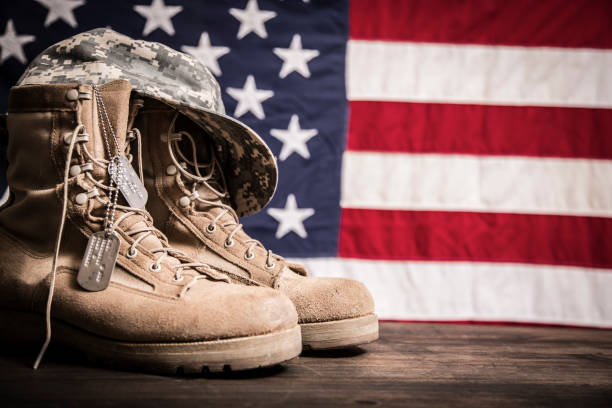
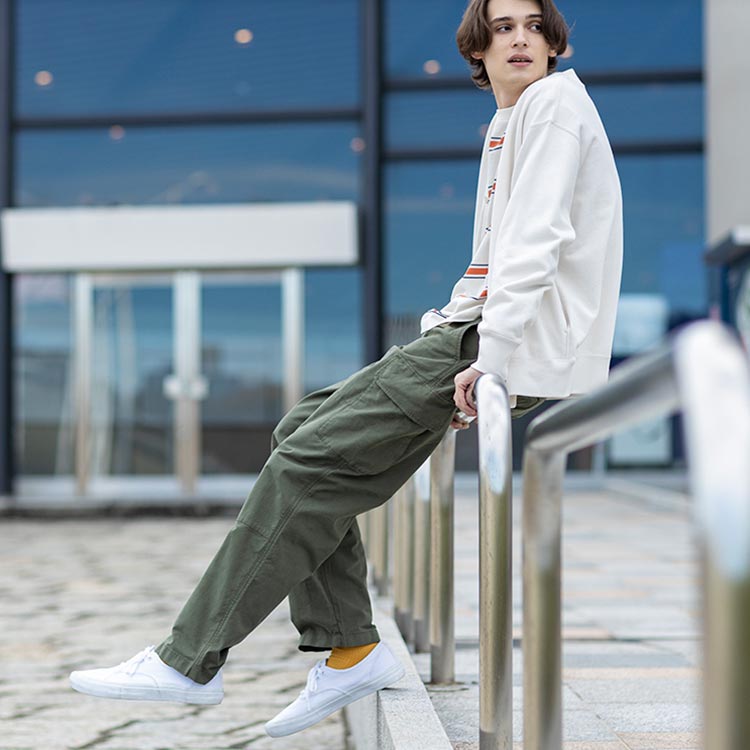
Patchwork and Insignia
Patches: Military cloth patches and insignia can be used to embellish jackets, shirts, and bags, adding an authentic military touch. A wide selection of patches can be found here online, find yours today.
Rank and Unit Symbols: These elements can be incorporated into designs to give a sense of authenticity and heritage.
Durable Materials
Fabrics: Heavy-duty fabrics such as canvas, denim, and ripstop are commonly used for their durability and rugged appearance.
Finishes: Garments may feature reinforced stitching, waterproofing, and other practical finishes such as velcro closures.
Utility Shirts and Henley’s
Utility Shirts: Button-up shirts with multiple pockets, often made from sturdy fabrics. Worn for farm or industrial work.
Henley Shirts: Collarless shirts with a few buttons at the neckline, inspired by military undershirts. In addition, men’s night shirts were also styled this way which re-emerged during the 1980’s.
Minimalist Color Palette
Colors: Earth tones like olive drab, khaki, brown, and black are prevalent, reflecting the surroundings and functional but subdued colors of military uniforms.
Backpacks and Bags
Design: Military-inspired backpacks and bags come in similar colours to a uniform and often feature multiple compartments, durable materials, and tactical designs. A good selection of styles and sizes can be found here today.
Usage: Popular for their practicality and robust construction, suitable for both everyday use and outdoor activities.
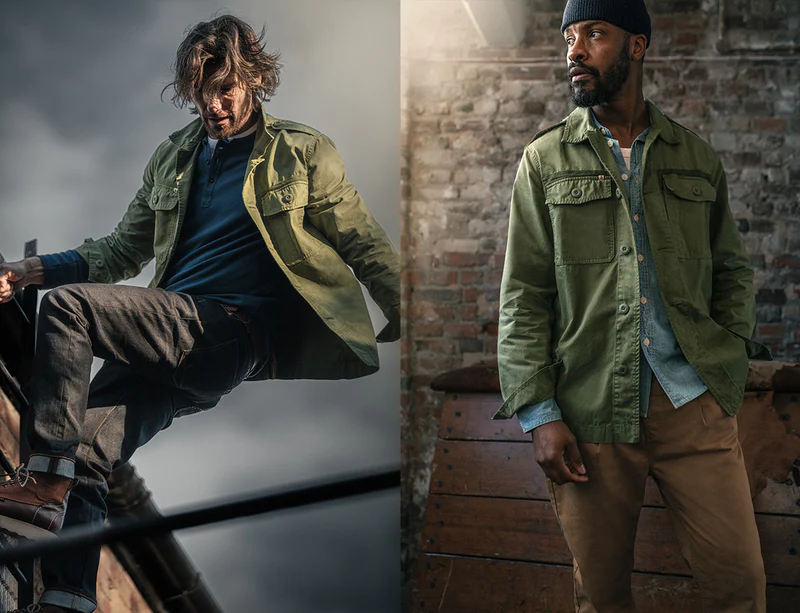
GI-inspired fashion integrates practicality, durability, and a rugged aesthetic into civilian clothing. These elements not only provide functional benefits but also carry cultural and symbolic significance, making them enduring and versatile components of contemporary fashion.
Post-war fashion resurgence and how GI elements were integrated
Post-war fashion in the late 1940’s and 1950’s saw a significant resurgence, characterized by a blend of practicality, luxury, with a nod to military elements. After World War II, the fashion industry experienced a revival that balanced the utilitarian styles of wartime with a renewed desire for elegance and femininity.
Key Elements of Post-War Fashion Resurgence
Dior’s “New Look” (1947):
- Christian Dior’s “New Look” (1947): was a pivotal moment in post-war fashion, featuring cinched waists, full skirts, and an emphasis on an hourglass silhouette. This look marked a dramatic departure from the austere and practical wartime styles.
- Return to Femininity:
- There was a strong emphasis on ultra-feminine designs, with softer fabrics, elaborate details, and a focus on creating a glamorous, polished and fresh appearance.
- Luxury Fabrics and Extravagance:
- With the end of wartime rationing, there was a renewed availability of luxurious fabrics such as silk, tulle, and satin. Designers embraced this opportunity to create opulent garments that celebrated abundance and indulgence.
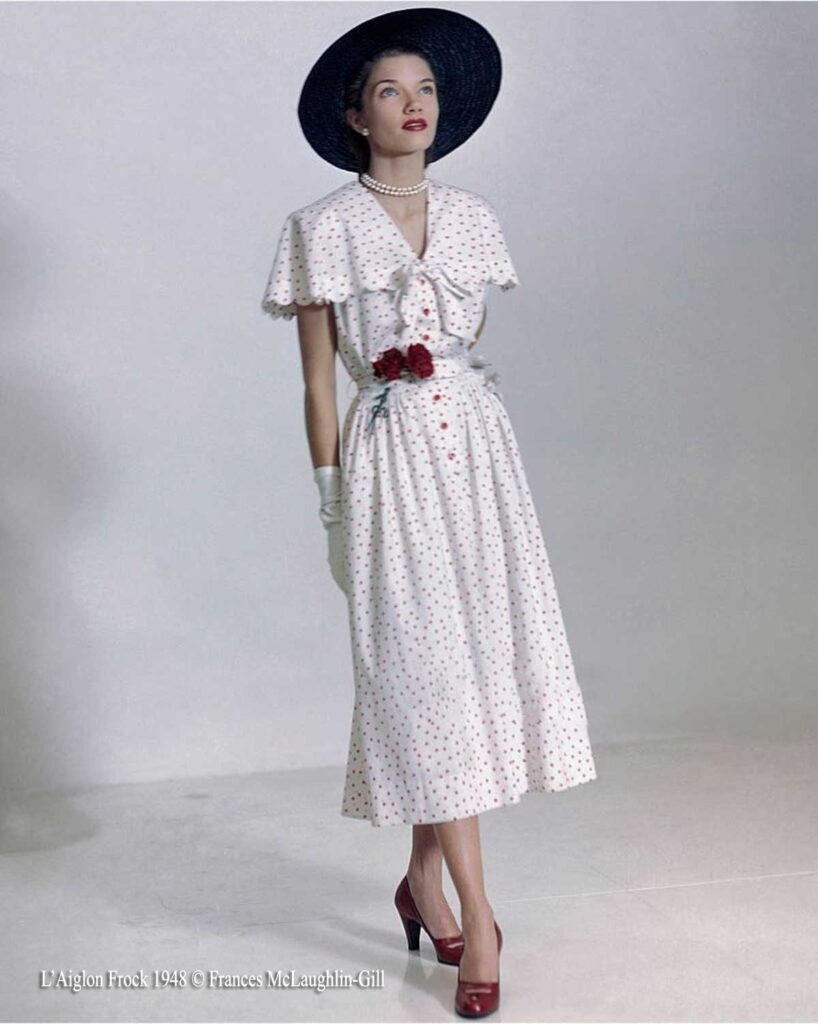
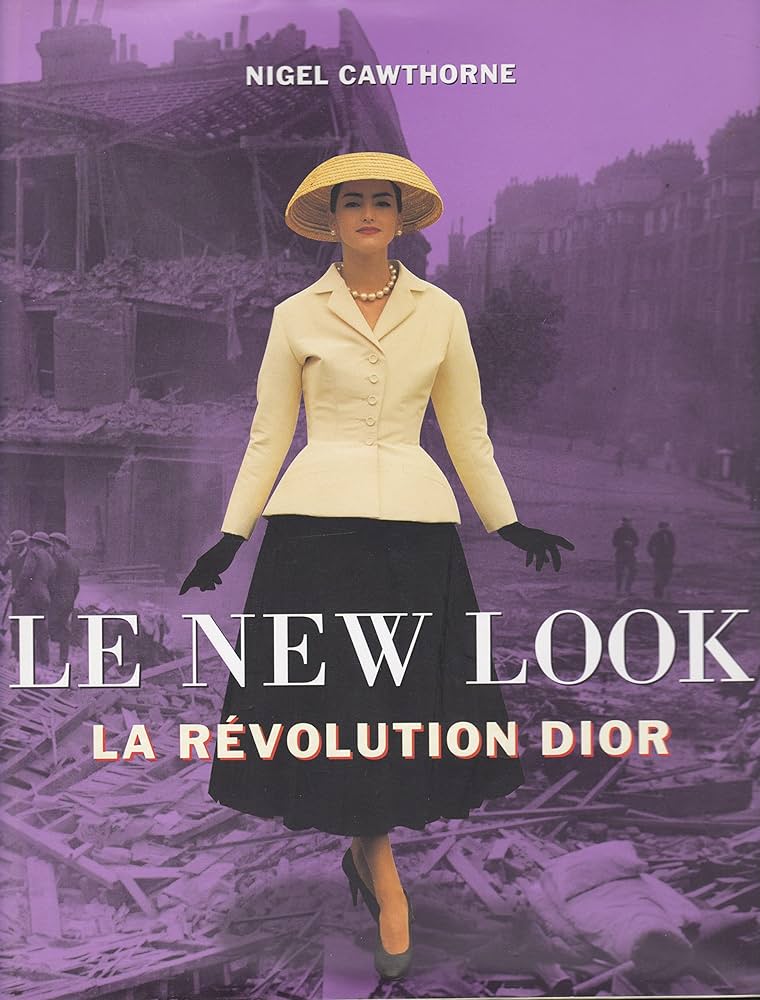
Integration of GI Elements
- Utilitarian Influences:
- The practical and functional aspects of military uniforms influenced post-war fashion. Features such as tailored trousers, trench coats, and the shirtwaist dresses became popular. These pieces were often reinterpreted with a more refined and stylish approach.
- Trench Coats:
- Originally designed for military use, trench coats became a staple in civilian wardrobes. They were adapted with fashionable details such as pleating and became synonymous with timeless elegance.
- Bomber Jackets:
- The bomber jacket – initially designed for pilots, found its way into mainstream fashion. It was later reimagined in different fabrics and colors, becoming a versatile piece for both men and women.
- Cargo Pockets and Belts:
- The utility of cargo pockets and belts, which were practical for soldiers, inspired similar features in civilian clothing or uniforms such as safari suits. These elements were often seen in casual wear, providing a rugged and functional aesthetic.
- Color Palette:
- Military-inspired colors such as khaki, olive green, and navy became popular in everyday fashion. These neutral colors added a sense of practicality and durability to post-war garments.
- Tailoring and Structure:
- The sharp tailoring and structured silhouettes of military uniforms influenced the design of post-war clothing. Blazers, pencil skirts, and tailored trousers reflected this trend, emphasizing a polished and authoritative look.
Cultural and Social Influences
- Economic Boom:
- The post-war economic boom allowed for greater consumer spending, leading to increased demand for fashionable clothing. This period saw the rise of ready-to-wear fashion, making stylish clothing more accessible to the general public.
- Hollywood Influence:
- Hollywood played a significant role in shaping post-war fashion. Film stars became style icons, and their on-screen wardrobes often set trends. The glamour and sophistication of Hollywood fashion resonated with the public, influencing everyday style choices.
- Youth Culture:
- The rise of youth culture in the 1950’s brought about new fashion trends. Teenagers began to assert their own style, often mixing traditional elements with modern influences. This period saw the emergence of subcultures such as the Teddy Boys a British subculture from the early 50’s to the mid 60’s, and Rock ‘n’ Roll fans worldwide – who had distinctive fashion preferences.
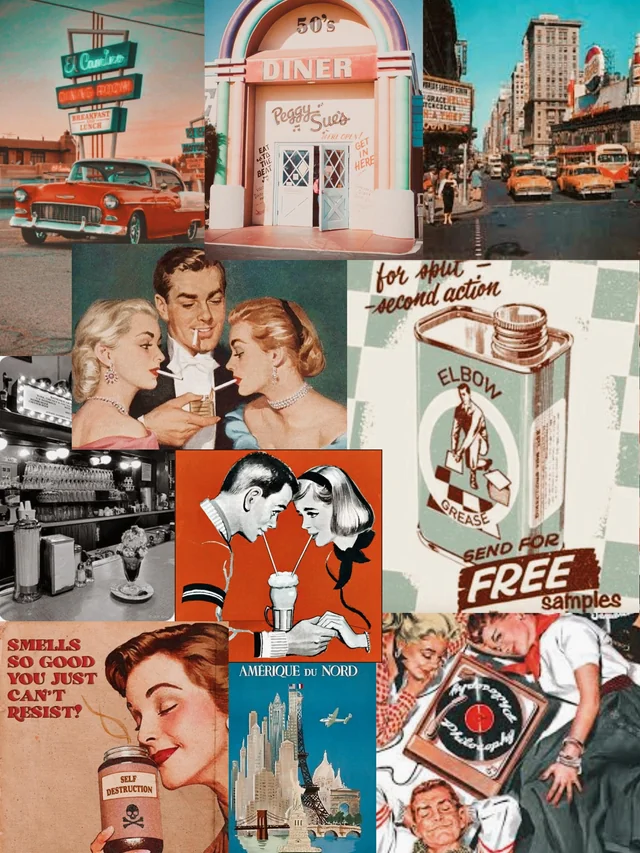
Post-war fashion resurgence was a period of dynamic change and innovation, blending the functional elements of military attire with a renewed appreciation for luxury and femininity. This era laid the foundation for many enduring fashion trends and continues to influence contemporary styles.
Influence of notable designers who adopted and transformed military styles
Military styles have had a significant impact on fashion, influencing various notable designers who adopted and transformed these elements into their collections. Here are some key designers and their contributions:
- Coco Chanel:
- Contribution: Coco Chanel is renowned for her use of military-inspired elements. During World War I, she used wool jersey, a fabric typically reserved for men’s underwear and military uniforms, to create comfortable, stylish, and practical women’s clothing.
- Transformation: Chanel’s designs included straight, boxy silhouettes and brass buttons, reminiscent of military attire. She made the look feminine yet functional, which was revolutionary at the time.
- Ralph Lauren:
- Contribution: Ralph Lauren’s collections often feature military-inspired pieces, reflecting his admiration for American heritage and classic styles.
- Transformation: He incorporates elements such as cargo pants, aviator jackets, and military coats, giving them a luxurious and timeless appeal.
- Burberry (Thomas Burberry):
- Contribution: Thomas Burberry invented gabardine fabric and designed the trench coat for British military officers during World War I.
- Transformation: The trench coat became a fashion icon, evolving from a practical military garment to a stylish wardrobe staple, adapted and modernized by various designers over the decades.
These designers have not only adopted military styles but have also transformed them, making them relevant and stylish for contemporary fashion. Their work demonstrates how military elements can be reinterpreted to create innovative and empowering fashion.
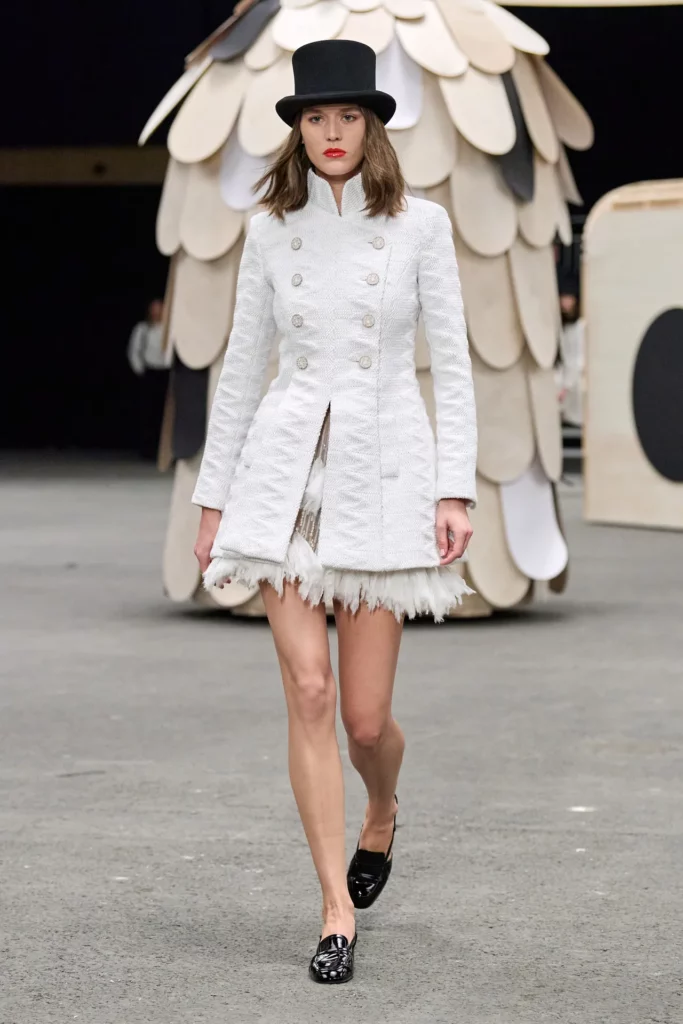
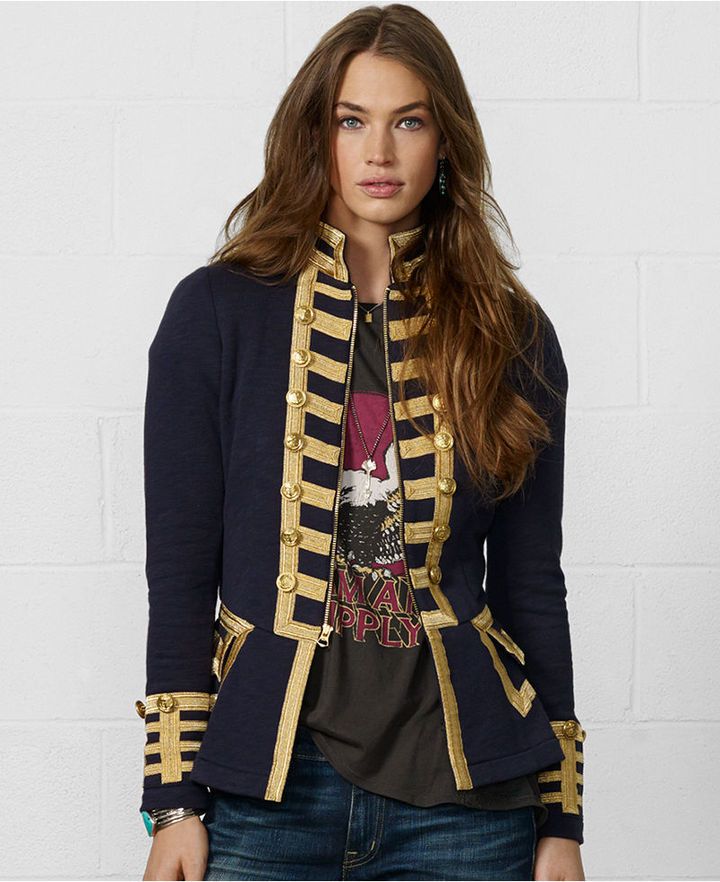
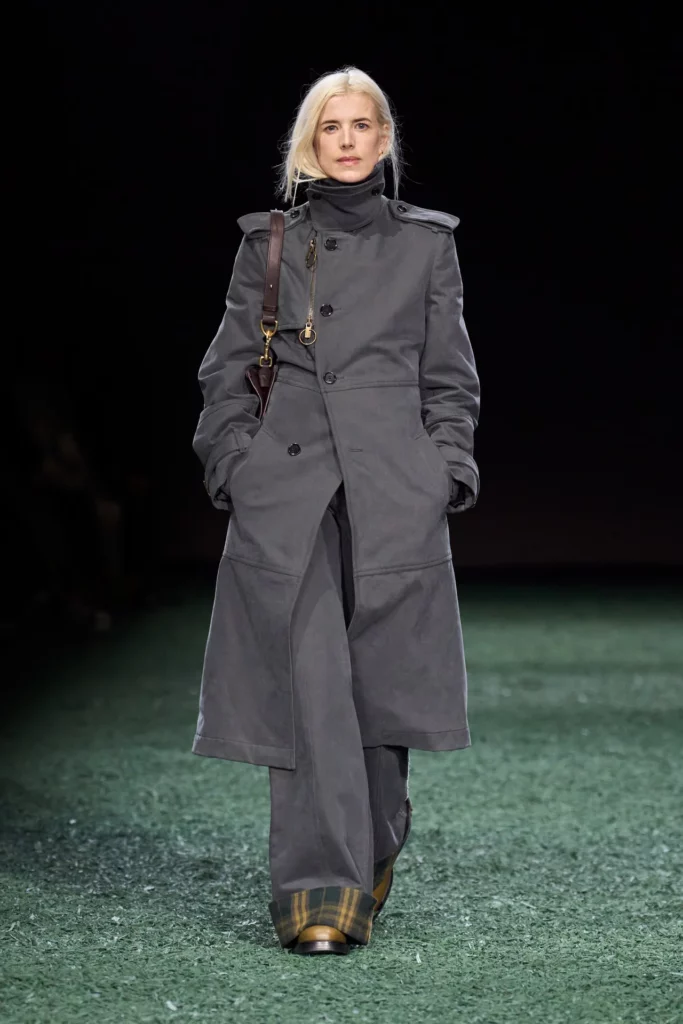
Practical advice for incorporating military-inspired pieces into modern wardrobes
Lets look at some practical tips for incorporating military-inspired pieces into a modern wardrobe which can add a sense of structure, functionality, and timeless style.
- Start with Classics:
- Field Jackets: A versatile piece that pairs well with jeans, chinos, or even a casual suit.
- Bomber Jackets: Great for layering and can be worn over t-shirts or button-down shirts.
- Trench Coats: A timeless outerwear option that works well in both casual and formal settings.
- Mix and Match:
- Combine military pieces with civilian clothing to avoid looking too uniform-like. For example, pair a camouflage jacket with a plain white tee and jeans.
- Use military pieces to balance more casual or formal items, like wearing a structured military coat over a dress.
- Neutral Colors:
- Military-inspired clothing often comes in neutral tones like olive green, khaki, and navy. These colors are easy to mix and match with other items in your wardrobe.
- Use these neutral pieces as a base and add pops of color through accessories or other garments.
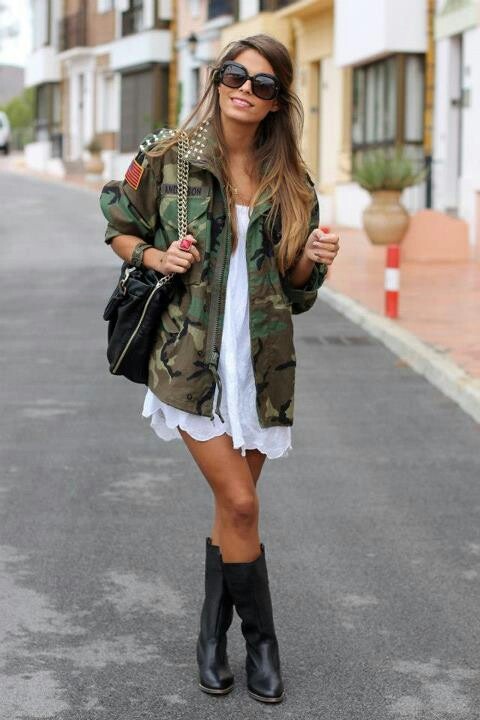
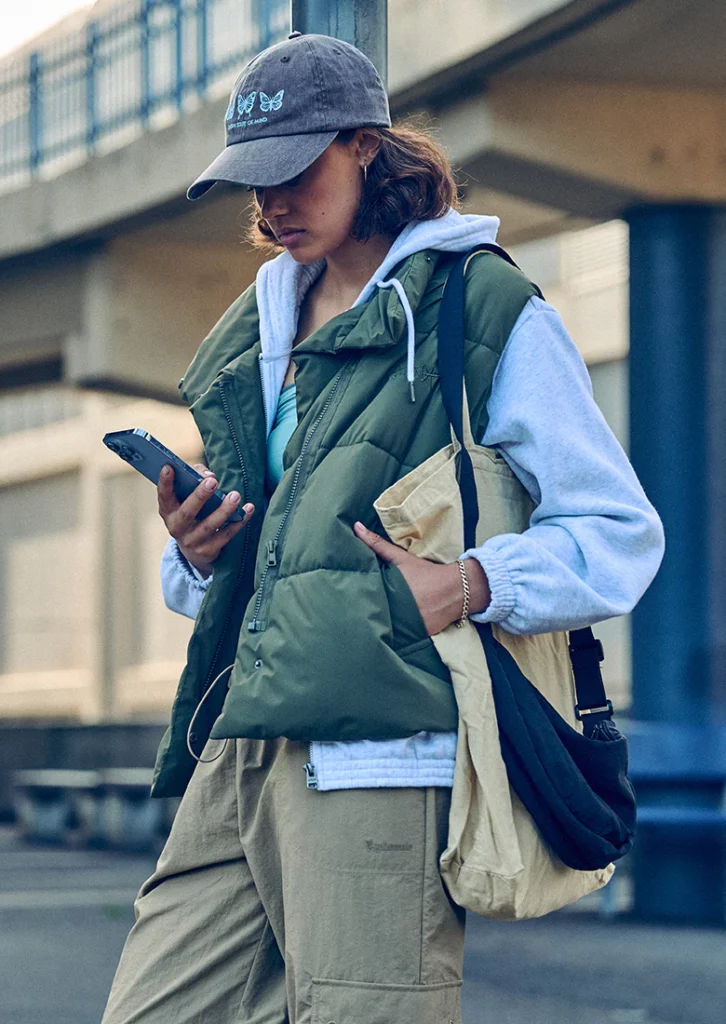
- Functional Accessories:
- Incorporate accessories like aviator sunglasses, utility belts, and combat boots to add a subtle but practical military touch, but don’t over accessorize.
- Look for bags and backpacks with a military aesthetic—think rugged or strong, materials with practical designs.
- Attention to Details:
- Military-inspired clothing often features distinctive details such as epaulets, cargo pockets, and sturdy buttons. Incorporate these elements as you focus on key pieces by adding interest and functionality to your outfits.
- Choose pieces with high-quality construction and durable fabrics, as these are key aspects of military design.
- Tailoring and Fit:
- Ensure your military-inspired pieces are well-fitted. While some items, like parkas and field jackets, are designed to be slightly over-sized, others, such as dress uniforms, should fit more snugly.
- Consider tailoring pieces like blazers or trousers to fit your body shape perfectly.
By thoughtfully incorporating these elements, you can achieve a stylish, modern look that pays homage to military fashion without looking overly uniformed.
Why khaki resonates with so many women
The colour khaki resonates with many women for several reasons:
Versatility: Khaki is a neutral color that pairs well with a wide range of other colors and patterns, making it easy to incorporate into various outfits. Its versatility means it can be dressed up or down for different occasions.
Timelessness: Khaki has a classic, timeless appeal that transcends trends. It’s often associated with enduring styles, such as military-inspired fashion and safari chic, which have long been staples in fashion.
Practicality: Khaki is a practical color that doesn’t show dirt or stains easily, making it a popular choice for everyday wear. Its practicality extends to its use in casual and work-wear, where functionality is often a priority rather than a fashionable item.
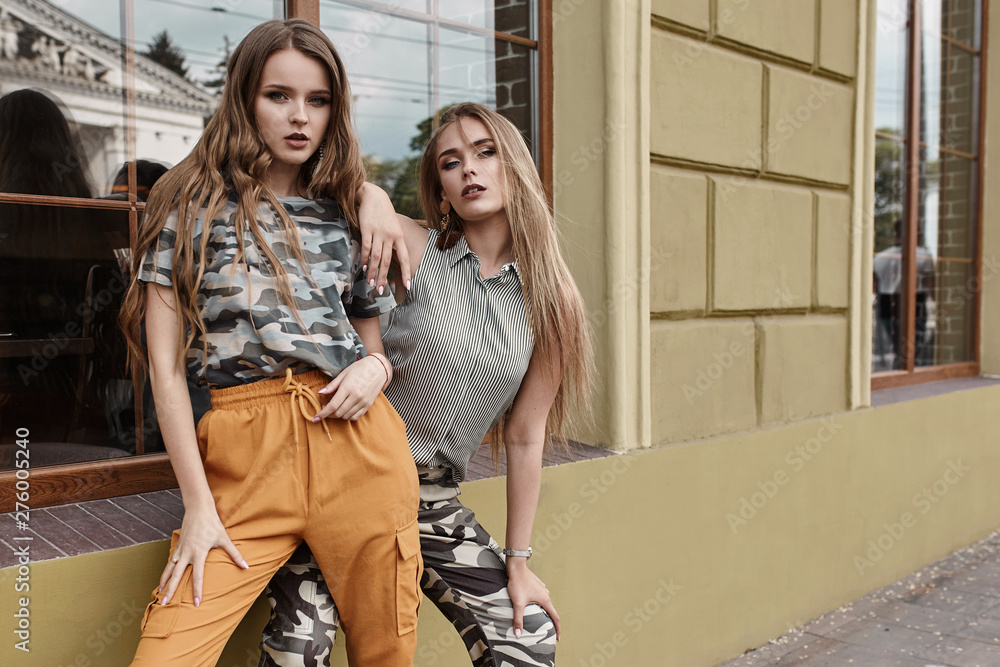
Comfort: Many khaki garments, such as chinos and cargo pants, are designed for comfort and ease of movement. This makes khaki a popular choice for women who prioritize comfort in their clothing.
Cultural Associations: It has historical and cultural associations that can influence its appeal. For example – it is often linked to adventure and exploration, evoking images of safaris and expeditions.
Seasonal Appeal: Khaki is a color that works well in all seasons. In summer, it pairs beautifully with lighter colors and fabrics, while in winter, it complements deeper hues and heavier materials.
Overall, khaki’s combination of versatility, timelessness, practicality, sophistication, comfort, cultural associations, and seasonal appeal contribute to its popularity among women.
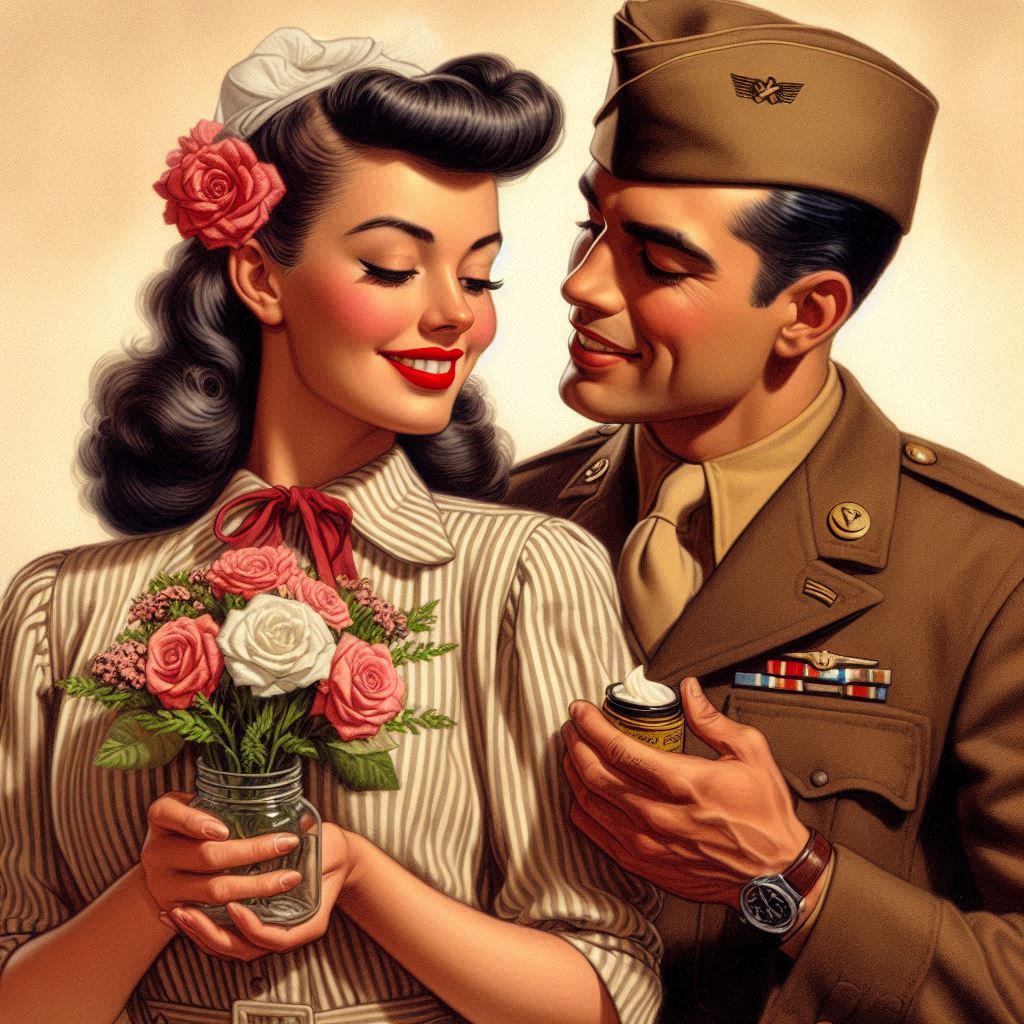
Thank you for taking the time to read this post on an incredible time in history, when so much changed due to the war – we experienced – hope you find some ideas about your “GI inspirations” when incorporating khaki into your wardrobe.
Connect with us via our socials or leave a comment below.
Helen.
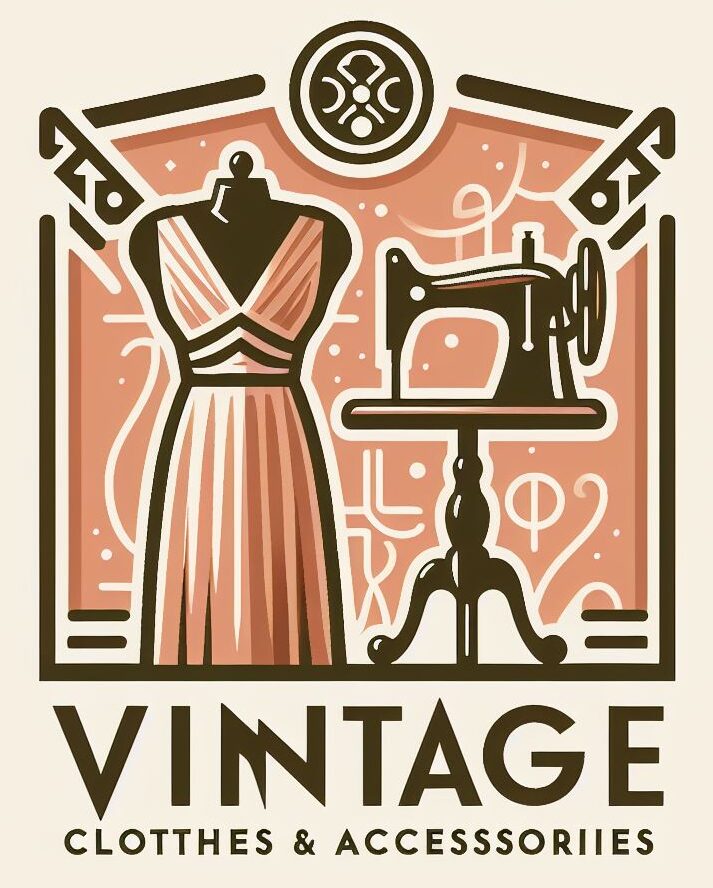
Hi there
Thanks for sharing this amazing article
I think the evolution of GI-inspired dressing during and after World War II is truly remarkable. The impact of the war on global fashion trends, especially in terms of resource scarcity and rationing, led to significant changes in clothing styles and materials. The introduction of utility clothing schemes and the influence of military uniforms on civilian fashion are key aspects that shaped the fashion landscape during that period. It’s fascinating to see how historical events can influence fashion choices and trends.
Indeed, it was such an amazing time – both tragic and significant all at once. Thanks again for your comments.